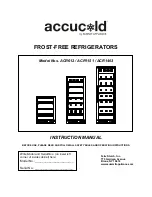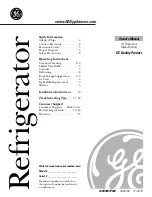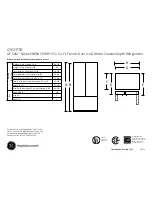
11
Tips for shopping the frozen foods
1.When you are buying frozen food, look at the
Storage Guidelines on the packaging. You will be
able to store each item of frozen food for the
period shown against the star rating. This is
usually t
he period stated as “Best to use them
before×”, found on the front of the packaging.
2.Check the temperature of the frozen food
cabinet in the shop where you buy the frozen
foods.
3.Make sure the frozen food package is in perfect
condition.
4.Always buy frozen products last on your
shopping trip or visit to the supermarket.
5.Try to keep frozen food together whilst
shopping and on the journey home, as this will
help to keep the food cooler.
6.Don’t buy frozen food unless you can freeze it
straight away. Special insulated bags can be
bought from most supermarkets and hardware
shops. These keep the frozen foods cold longer.
7.For some foods, thawing before cooking is
unnecessary. Vegetables and pasta can be added
directly to boiling water or steam cooked. Frozen
sauces and soups can be put into a saucepan and
heated gently until thawed.
8.Use quality food and handle it as little as
possible. When foods are frozen in small
quantities, it will take less than for them to
freeze up and thaw.
9.Estimate the amount of foods to be frozen up.
When freezing large amounts of fresh food,
adjust the temperature control knob to the low
mode, with the freezer temperature lowered. So,
foods can be frozen up in fast manner, with the
food freshness well kept.
Tips for special needs
Moving the refrigerator/freezer
•
Location
Do not place your refrigerator/freezer near a heat
source, e.g. cooker, boiler or radiator. Avoid it
from direct sunlight in out-buildings or sun
lounges.
•Leveling
Make sure to level your refrigerator/freezer using
the front leveling feet. If not level, the
refrigerator/freezer
door
gasket
sealing
performance will be affected, or even it may lead
to
the
operating
failure
of
your
refrigerator/freezer.
After locating the refrigerator/freezer in position,
wait for 4 hours before using it, so as to allow the
refrigerant to settle.
•
Installation
Do not cover or block the vents or grilles of your
appliance.
When you are out for a long time
•
If the appliance will not be used for several
months, turn it off first, and then unplug the
plug from the wall outlet.
•
Take out all foods.
•
Clean and dry the interior thoroughly. To
prevent odor and mold growth, leave the door
ajar: block it open or have the door removed if
necessary.
•
Keep the cleaned appliance in a dry, ventilated
place and away from the heat source, place the
appliance smoothly, and do not place heavy
objects on top of it.
•
The unit should not be accessible to child’s play.
Maintenance and cleaning
Before cleaning, unplug the power plug
first; Do not plug in or plug out the plug with wet
hand, because there is a risk of electric shock and
injury. Do not spill water directly on the
refrigerator, to avoid rust, electricity leakage and
accidents. Do not stretch your hands into the
bottom of the refrigerator, since you might be
scratched by sharp metal corners.
Internal cleaning and external cleaning
The food residuals in the refrigerator are liable to
produce bad odor, so the refrigerator must be
cleaned regularly. The fresh food compartment is
usually cleaned once a month.
Remove all shelves, crisper box, bottle racks,
cover board, and drawers etc., and clean them
with a soft towel or sponge dipped in warm water
or neutral detergent.
Clear off the dusts accumulated on the rear panel
and side plates of the refrigerator often.
After using detergent, be sure to rinse it with clean
water, and then wipe it dry.
Do not use bristle brush, steel wire brush,
detergent, soap powder, alkaline detergent,
benzene, gasoline, acid, hot water and other
corrosive or soluble items to cleanse the cabinet
surface, door gasket, plastic decorative parts,
etc., so as to avoid damage.
Carefully wipe dry the door gasket, clean the
groove using a wooden chopstick wrapped with
cotton string. After the cleaning, fix the four
corners of the door gasket first, and then embed
Summary of Contents for MINI CITY COMBI M.
Page 1: ...USER MANUAL MINI CITY COMBI M...
Page 17: ...15 doors before tightening the hinge screws...
Page 108: ...106 18 C 11 20 25 C 10 12 38 C 18 10 42 C 30 15...
Page 109: ...107 20 4 Wine Cooler...
Page 110: ...108 Wine Cooler...
Page 111: ...109 Wine Cooler...
Page 112: ...110 Wine Cooler...
Page 113: ...111 8 220 240VAC 50 60 Hz inverter SN 10 C 32 C N 16 C 32 C ST 16 C 38 C T 16 C 43 C...
Page 114: ...112 Freon freon R600a cyclopentane R600a 1 2 3 4 5 6 7 1 8 g M3 2 300 100 50 3...
Page 115: ...113 1 1 2 3 1 4 2 3 4 1 7 1 7 4 0 Fast Freeze 1 2 7 3 4...
Page 116: ...114 2 8 C...
Page 117: ...115 18 C 1 2 3 4 supermarket 5 6 supermarkets 7 8 9...
Page 118: ...116 4 1 2 5mm...
Page 119: ...117 3 1 2 1 OFF 2 3 4 10W...
Page 120: ...118 2012 19...
Page 121: ...119 6 1 2 3 4 5 6...
Page 122: ...120 7 8...
Page 207: ...205 20...
Page 208: ...206 4...
Page 209: ...207...
Page 210: ...208...
Page 211: ...209 220 240V AC 50 60Hz...
Page 212: ...210 SN 10 C 32 C N 16 C 32 C ST 16 C 38 C T 16 C 43 C R600a R600a 1 2 3 4 5 6 7 1 8 3...
Page 213: ...211 2 300 100 50 3 1 1 2 3 1 4 2 3 4 1 7 1 7 4 0 1 2 7 3...
Page 214: ...212 4 2 8...
Page 215: ...213 18 1 2 3 4 5 6 7 8 9 4...
Page 216: ...214 Ph 1 2 5 3 1...
Page 217: ...215 2 1 OFF 2 3 4 10 W...
Page 218: ...216 EEC 8 2012 19...
Page 219: ...217 6 1 2 3 4 5 6...
Page 220: ...218 7 8...














































